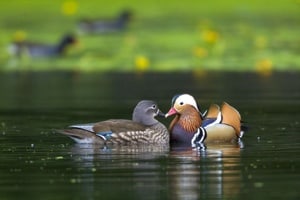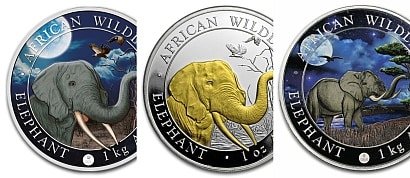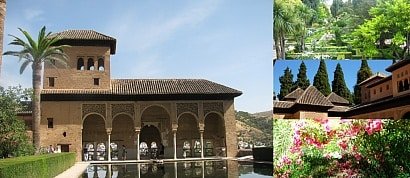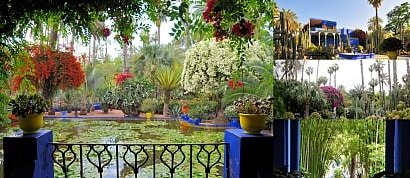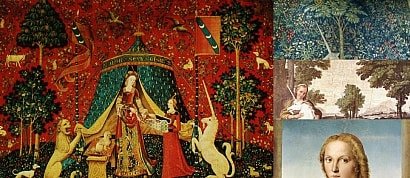Mandarin Ducks
Birds renowned for beauty and symbols of faithful love
~
The Mandarin duck (Aix galericulata), or just Mandarin, is a perching duck species found in East Asia. It is medium-sized, at 41–49 cm long with a 65–75 cm wingspan. As the other member of the genus Aix, it is closely related to the North American wood duck.
DESCRIPTION
The adult male is a striking and unmistakable bird. It has a red bill, large white crescent above the eye and reddish face and "whiskers". The breast is purple with two vertical white bars, and the flanks ruddy, with two orange "sails" at the back. The female is similar to female wood duck, with a white eye-ring and stripe running back from the eye, but is paler below, has a small white flank stripe, and a pale tip to its bill.
Mandarin ducklings are almost identical in look to wood ducklings, and appear very similar to mallard ducklings. The ducklings can be distinguished from mallard ducklings because the eye-stripe of Mandarin ducklings (and wood ducklings) stops at the eye, while in mallard ducklings it reaches all the way to the bill.
MUTATIONS
There are various mutations of the Mandarin duck found in captivity. The most common is the white Mandarin duck. Although the origin of this mutation is unknown, it is presumed that the constant pairing of related birds and selective breeding led to recessive gene combinations leading to genetic conditions including albinism.
DISTRIBUTION AND HABITAT
The species was once widespread in East Asia, but large-scale exports and the destruction of its forest habitat have reduced populations in eastern Russia and in China to below 1,000 pairs in each country; Japan, however, is thought to still hold some 5,000 pairs. The Asian populations are migratory, overwintering in lowland eastern China and southern Japan.
Specimens frequently escape from collections, and in the 20th century a large feral population was established in Great Britain; more recently small numbers have bred in Ireland, concentrated in the parks of Dublin. There are now about 7,000 in Britain, and other populations on the European continent, the largest in the region of Berlin. Isolated populations exist in the United States. The town of Black Mountain, North Carolina has a limited population, and there is a free-flying feral population of several hundred mandarins in Sonoma County, California. This population is the result of several Mandarin ducks escaping from captivity, then going on to reproduce in the wild.
The habitats it prefers in its breeding range are the dense, shrubby forested edges of rivers and lakes. It mostly occurs in low-lying areas, but it may breed in valleys at altitudes of up to 1,500 metres (4,900 ft). In winter, it additionally occurs in marshes, flooded fields, and open rivers. While it prefers freshwater, it may also be seen wintering in coastal lagoons and estuaries. In its introduced European range, it lives in more open habitat than in its native range, around the edges lakes, water meadows, and cultivated areas with woods nearby.
BREEDING
In the wild, Mandarin ducks breed in densely wooded areas near shallow lakes, marshes or ponds. They nest in cavities in trees close to water and during the spring, the females lay their eggs in the tree's cavity after mating. A single clutch of nine to twelve eggs is laid in April or May. Although the male may defend the brooding female and his eggs during incubation, he himself does not incubate the eggs and leaves before they hatch. Shortly after the ducklings hatch, their mother flies to the ground and coaxes the ducklings to leap from the nest. After all of the ducklings are out of the tree, they will follow their mother to a nearby body of water.
FOOD AND FEEDING
Mandarins feed by dabbling or walking on land. They mainly eat plants and seeds, especially beech mast. The species will also add snails, insects and small fish to its diet. The diet of Mandarin ducks changes seasonally; in the fall and winter, they mostly eat acorns and grains. In the spring they mostly eat insects, snails, fish and aquatic plants. In the summer, they eat dew worms, small fish, frogs, mollusks, and small snakes. They feed mainly near dawn or dusk, perching in trees or on the ground during the day.
THREATS
Predation of the Mandarin duck varies between different parts of its range. Mink, raccoon dogs, otters, polecats, Eurasian eagle owls, and grass snakes are all predators of the Mandarin duck. The greatest threat to the Mandarin duck is habitat loss due to loggers. Hunters are also a threat to the Mandarin duck, because often they are unable to recognize the Mandarin in flight and as a result, many are shot by accident. Mandarin ducks are not hunted for food, however they are still poached because their extreme beauty is prized.
IN CHINESE CULTURE
Mandarin ducks are referred to by the Chinese as Yuan-yang (simplified Chinese: 鸳鸯; traditional Chinese: 鴛鴦; pinyin: yuān yāng), where yuan (鴛) and yang (鴦) respectively stand for male and female Mandarin ducks. In traditional Chinese culture, Mandarin ducks are believed to be lifelong couples, unlike other species of ducks. Hence they are regarded as a symbol of conjugal affection and fidelity, and are frequently featured in Chinese art. A Chinese proverb for loving couples uses the Mandarin duck as a metaphor: "Two mandarin ducks playing in water" (simplified Chinese: 鸳鸯戏水; traditional Chinese: 鴛鴦戲水; pinyin: yuān yāng xì shuǐ). A Mandarin duck symbol is also used in Chinese weddings because in traditional Chinese lore, they symbolize wedded bliss and fidelity. Because the male and female plumages of the Mandarin duck are so unalike, yuan-yang is frequently used colloquially in Cantonese to mean an "odd couple" or "unlikely pair" – a mixture of two different types of same category. For example, the drink yuanyang and yuan-yang fried rice.
IN KOREAN CULTURE
For Koreans, Mandarin ducks represent peace, fidelity, and plentiful offspring. Similar to the Chinese, they believe that these ducks mate for life. For these reasons, pairs of Mandarin ducks called wedding ducks are often given as wedding gifts and play a significant role in Korean marriage.
(Wikipedia)
~
The Mandarin duck (Aix galericulata), or just Mandarin, is a perching duck species found in East Asia. It is medium-sized, at 41–49 cm long with a 65–75 cm wingspan. As the other member of the genus Aix, it is closely related to the North American wood duck.
DESCRIPTION
The adult male is a striking and unmistakable bird. It has a red bill, large white crescent above the eye and reddish face and "whiskers". The breast is purple with two vertical white bars, and the flanks ruddy, with two orange "sails" at the back. The female is similar to female wood duck, with a white eye-ring and stripe running back from the eye, but is paler below, has a small white flank stripe, and a pale tip to its bill.
Mandarin ducklings are almost identical in look to wood ducklings, and appear very similar to mallard ducklings. The ducklings can be distinguished from mallard ducklings because the eye-stripe of Mandarin ducklings (and wood ducklings) stops at the eye, while in mallard ducklings it reaches all the way to the bill.
MUTATIONS
There are various mutations of the Mandarin duck found in captivity. The most common is the white Mandarin duck. Although the origin of this mutation is unknown, it is presumed that the constant pairing of related birds and selective breeding led to recessive gene combinations leading to genetic conditions including albinism.
DISTRIBUTION AND HABITAT
The species was once widespread in East Asia, but large-scale exports and the destruction of its forest habitat have reduced populations in eastern Russia and in China to below 1,000 pairs in each country; Japan, however, is thought to still hold some 5,000 pairs. The Asian populations are migratory, overwintering in lowland eastern China and southern Japan.
Specimens frequently escape from collections, and in the 20th century a large feral population was established in Great Britain; more recently small numbers have bred in Ireland, concentrated in the parks of Dublin. There are now about 7,000 in Britain, and other populations on the European continent, the largest in the region of Berlin. Isolated populations exist in the United States. The town of Black Mountain, North Carolina has a limited population, and there is a free-flying feral population of several hundred mandarins in Sonoma County, California. This population is the result of several Mandarin ducks escaping from captivity, then going on to reproduce in the wild.
The habitats it prefers in its breeding range are the dense, shrubby forested edges of rivers and lakes. It mostly occurs in low-lying areas, but it may breed in valleys at altitudes of up to 1,500 metres (4,900 ft). In winter, it additionally occurs in marshes, flooded fields, and open rivers. While it prefers freshwater, it may also be seen wintering in coastal lagoons and estuaries. In its introduced European range, it lives in more open habitat than in its native range, around the edges lakes, water meadows, and cultivated areas with woods nearby.
BREEDING
In the wild, Mandarin ducks breed in densely wooded areas near shallow lakes, marshes or ponds. They nest in cavities in trees close to water and during the spring, the females lay their eggs in the tree's cavity after mating. A single clutch of nine to twelve eggs is laid in April or May. Although the male may defend the brooding female and his eggs during incubation, he himself does not incubate the eggs and leaves before they hatch. Shortly after the ducklings hatch, their mother flies to the ground and coaxes the ducklings to leap from the nest. After all of the ducklings are out of the tree, they will follow their mother to a nearby body of water.
FOOD AND FEEDING
Mandarins feed by dabbling or walking on land. They mainly eat plants and seeds, especially beech mast. The species will also add snails, insects and small fish to its diet. The diet of Mandarin ducks changes seasonally; in the fall and winter, they mostly eat acorns and grains. In the spring they mostly eat insects, snails, fish and aquatic plants. In the summer, they eat dew worms, small fish, frogs, mollusks, and small snakes. They feed mainly near dawn or dusk, perching in trees or on the ground during the day.
THREATS
Predation of the Mandarin duck varies between different parts of its range. Mink, raccoon dogs, otters, polecats, Eurasian eagle owls, and grass snakes are all predators of the Mandarin duck. The greatest threat to the Mandarin duck is habitat loss due to loggers. Hunters are also a threat to the Mandarin duck, because often they are unable to recognize the Mandarin in flight and as a result, many are shot by accident. Mandarin ducks are not hunted for food, however they are still poached because their extreme beauty is prized.
IN CHINESE CULTURE
Mandarin ducks are referred to by the Chinese as Yuan-yang (simplified Chinese: 鸳鸯; traditional Chinese: 鴛鴦; pinyin: yuān yāng), where yuan (鴛) and yang (鴦) respectively stand for male and female Mandarin ducks. In traditional Chinese culture, Mandarin ducks are believed to be lifelong couples, unlike other species of ducks. Hence they are regarded as a symbol of conjugal affection and fidelity, and are frequently featured in Chinese art. A Chinese proverb for loving couples uses the Mandarin duck as a metaphor: "Two mandarin ducks playing in water" (simplified Chinese: 鸳鸯戏水; traditional Chinese: 鴛鴦戲水; pinyin: yuān yāng xì shuǐ). A Mandarin duck symbol is also used in Chinese weddings because in traditional Chinese lore, they symbolize wedded bliss and fidelity. Because the male and female plumages of the Mandarin duck are so unalike, yuan-yang is frequently used colloquially in Cantonese to mean an "odd couple" or "unlikely pair" – a mixture of two different types of same category. For example, the drink yuanyang and yuan-yang fried rice.
IN KOREAN CULTURE
For Koreans, Mandarin ducks represent peace, fidelity, and plentiful offspring. Similar to the Chinese, they believe that these ducks mate for life. For these reasons, pairs of Mandarin ducks called wedding ducks are often given as wedding gifts and play a significant role in Korean marriage.
(Wikipedia)
Added to
13 votes
My Own Favourite Lists
(118 lists)list by Kenji
Published 10 years, 6 months ago  1 comment
1 comment
 1 comment
1 commentPeople who voted for this also voted for
Netherlands Tulips
Cigarette Cards: Birds & Animals of Australia
spread your wings
Nature Photography by Alex Saberi
Malaysia
Bullion Rounds: Copper
Mexican Lobby Cards (35)
Maternità della Beata Vergine Maria
Beautiful Korean Faces - Kim Tae-hee
Santa Maria Maddalena
Beautiful Chinese Faces - Zhang Xinyuan
Food & Drink...The Best Tropical Fruits
Western Movie Posters: Jack Hoxie
Cherry Blossom Wallpaper
Bullion Coins: Silver Elephant Series (colorized)
More lists from Kenji
Great Gardens: Alhambra, Spain
Great Gardens: Zhuozheng Yuan, Suzhou, China
My Great Gardens Lists
Great Gardens: Butchart, Victoria, Canada
The Art of Mythical Creatures
Great Gardens: Ryoan-ji, Kyoto, Japan
Paintings of Ships and Boats
 Login
Login

